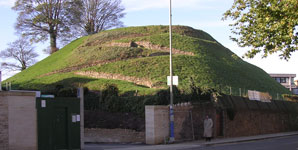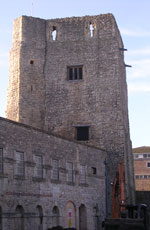Archives and Artefacts
Exploring the Past through the Work of E.T. Leeds and A2A
| |
| |
| |
| |
| |
| |
ANGLO-SAXON OXFORDSHIRE
Norman Oxford
The castle is the most striking feature of the Norman Conquest in Oxford. The Annals of Oseney Abbey state that the castle was build by Robert d’Oilly in 1071 on the western edge of the Saxon town.
 |
 |
Motte of Oxford Castle |
St George's tower at Oxford Castle |
Recent research and excavations have shown that three structures survive from this period:
- The motte – is approximately 65m in diameter at the base and 23m in diameter at the top. It stands 18m high. A moat ran around the base of the motte and a timber tower probably originally stood on top of the motte.
- Chapel of St George in the Castle stood on the southwest edge of the bailey, south of the motte. Only the crypt of this chapel is still in existence.
- St George’s Tower is said to have been the bell tower of the church but may actually predate it. Both these structures are related to the foundation of the collegiate church of St George in 1074 by Robert d’Oilly and Roger D’Ivri. The tower may pre-date the conquest and may in fact have served as a gate tower in the late Saxon town.
During the twelfth and thirteenth centuries Oxford continued to grow and expand becoming an important centre for trade in corn, wool, cloth and leather. In the twelfth century Oxford also became an important clerical centre training scholars, which of course eventually led to the foundation of the university.
©
Copyright University of Oxford, Ashmolean Museum, 2005. Last updated: 22-December-2005 About this Website